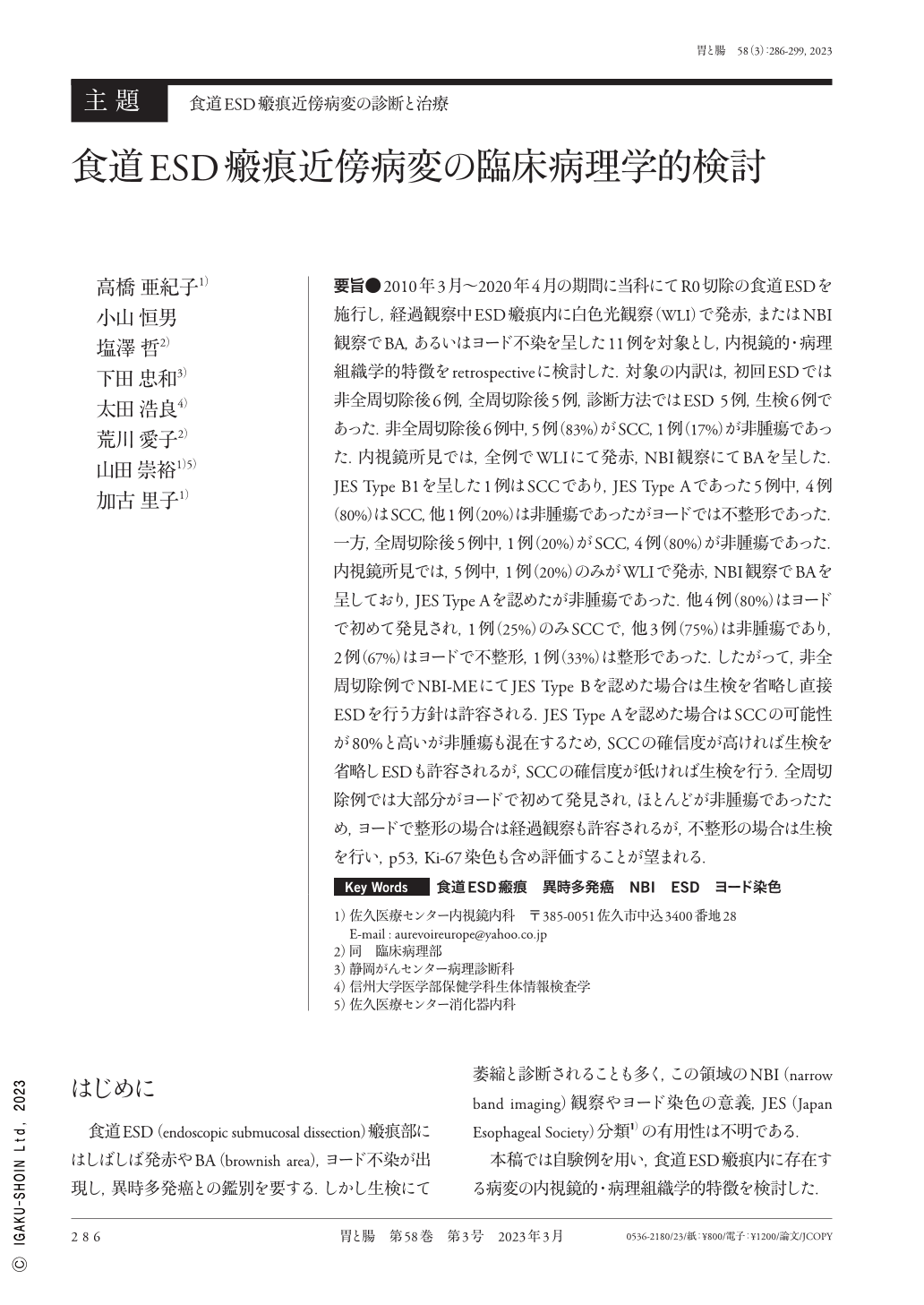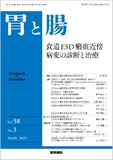Japanese
English
- 有料閲覧
- Abstract 文献概要
- 1ページ目 Look Inside
- 参考文献 Reference
要旨●2010年3月〜2020年4月の期間に当科にてR0切除の食道ESDを施行し,経過観察中ESD瘢痕内に白色光観察(WLI)で発赤,またはNBI観察でBA,あるいはヨード不染を呈した11例を対象とし,内視鏡的・病理組織学的特徴をretrospectiveに検討した.対象の内訳は,初回ESDでは非全周切除後6例,全周切除後5例,診断方法ではESD 5例,生検6例であった.非全周切除後6例中,5例(83%)がSCC,1例(17%)が非腫瘍であった.内視鏡所見では,全例でWLIにて発赤,NBI観察にてBAを呈した.JES Type B1を呈した1例はSCCであり,JES Type Aであった5例中,4例(80%)はSCC,他1例(20%)は非腫瘍であったがヨードでは不整形であった.一方,全周切除後5例中,1例(20%)がSCC,4例(80%)が非腫瘍であった.内視鏡所見では,5例中,1例(20%)のみがWLIで発赤,NBI観察でBAを呈しており,JES Type Aを認めたが非腫瘍であった.他4例(80%)はヨードで初めて発見され,1例(25%)のみSCCで,他3例(75%)は非腫瘍であり,2例(67%)はヨードで不整形,1例(33%)は整形であった.したがって,非全周切除例でNBI-MEにてJES Type Bを認めた場合は生検を省略し直接ESDを行う方針は許容される.JES Type Aを認めた場合はSCCの可能性が80%と高いが非腫瘍も混在するため,SCCの確信度が高ければ生検を省略しESDも許容されるが,SCCの確信度が低ければ生検を行う.全周切除例では大部分がヨードで初めて発見され,ほとんどが非腫瘍であったため,ヨードで整形の場合は経過観察も許容されるが,不整形の場合は生検を行い,p53,Ki-67染色も含め評価することが望まれる.
A reddish flat lesion that shows a BA(brownish area)by NBI(narrow band imaging)and an iodine-unstained area was found on the esophageal ESD(endoscopic submucosal dissection)scar.
Eleven lesions in the scar after curative ESD from March 2010 to April 2020 were enrolled in this retrospective study. The endoscopic and histopathological features were examined. Six and five cases were diagnosed after non circumferential and whole circumferential ESD, respectively.
In six cases that were diagnosed after noncircumferential ESD, five(83%)were SCC(squamous cell carcinoma)and one(17%)was a nonneoplastic lesion. All of 6 cases showed redness by WLI(white light image)and BA by NBI. One lesion which showed JES(Japan Esophageal Society)Type B1 was SCC, while JES Type A was present in five cases. SCC and nonneoplastic lesions were present in four and one cases, respectively.
In five cases that were diagnosed following whole circumferential ESD, one(20%)was SCC and four(80%)were nonneoplastic lesions. Endoscopically, four of five cases were not identified via WLI or NBI but were diagnosed using iodine. The only SCC showed no findings by WLI and NBI, but iodine showed unstained lesion and diagnosed as SCC by biopsy.
Based on our results, we suggest diagnosing the lesions in ESD scars as follows:when the lesion displayed JES Type B1 in noncircumferential ESD cases and direct ESD is acceptable, 80% of the lesions with JES Type A were SCC. As a result, if the endoscopic diagnosis is made with high confidence, direct ESD is acceptable ; however, if it is made with low confidence, taking a biopsy is recommended. After complete circumferential ESD, 80% of the lesions were nonneoplastic lesions. Follow-up is therefore permitted in situations when the iodine-unstained area is regular. An irregularly shaped, unstained region requires a biopsy diagnosis with p53 and Ki-67.

Copyright © 2023, Igaku-Shoin Ltd. All rights reserved.


